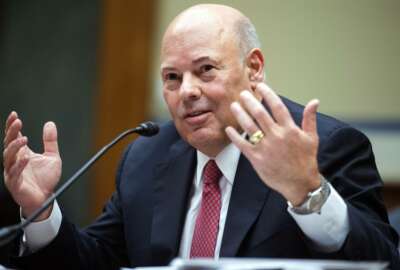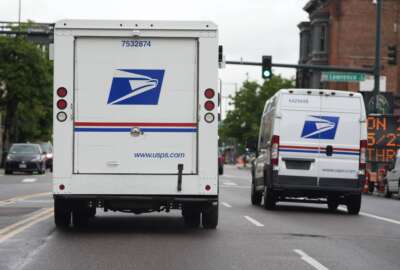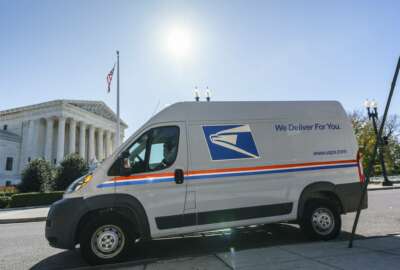

Hubbard Radio Washington DC, LLC. All rights reserved. This website is not intended for users located within the European Economic Area.
The Postal Service, having struggled with employee availability issues since the start of the COVID-19 pandemic, is telling Congress it has the stable workforce...
The Postal Service, having struggled with employee availability issues since the start of the COVID-19 pandemic, is telling Congress it has the stable workforce it needs to meet high expectations for this year’s holiday season.
Gregory White, USPS executive manager of strategic initiatives, told the House Oversight and Reform Committee’s subcommittee on government operations that service performance “is much better now” than in the lead-up to the holiday seasons in 2021 and 2020.
“We are not the organization we were two years ago, during the challenging 2020 peak season, amidst a global pandemic,” White said Wednesday. “While headwinds remain, we are now structured for precision. We are an organization better positioned to meet the country’s evolving mailing and shipping needs, working to do so in a financially self-supporting manner.”
USPS is hiring 20,000 seasonal employees to prepare for its peak season holiday operations, less than half the number of temporary hires it has recruited in recent years. Last year, USPS hired more than 51,000 temporary employees to prepare for its busy year-end period, according to a USPS inspector general report released this summer.
USPS expects it will need fewer seasonal hires this year, because it has converted more than 100,000 employees from part-time to full-time career positions over the past two years. This year alone, USPS converted 41,000 part-time positions to full-time status.
“The reality is that this year we are less dependent on peak-season heroics than we have been in the past,” White said.
White said USPS supervisor vacancies are also down, compared to recent years.
“We have more experienced, knowledgeable management within those facilities and employee availability is up throughout the country, so yes, we are staffed,” White said.
USPS Inspector General Tammy Whitcomb Hull said USPS has a “reasonable plan” to handle the peak season, and did not issue any recommendations in a recent audit of the agency’s year-end preparations.
USPS plans this year, she added, build on a strategy that began last year to retain more employees and facilities year-round, rather than scale up operations at the end of the year. That means USPS can afford to hire fewer temporary employees and lease less temporary space this year compared to last year.
USPS management told the IG’s office that the agency expects to still provide timely delivery because it has more experienced employees, higher employee availability and “an overall more stable workforce,” Hull said.
USPS managers also told OIG they do not expect an increase in mail and package volume compared to last year. Hull said the only challenge USPS faces is acquiring as much temporary leased space as it seeks.
“The Postal Service said acquiring temporary annexes can be difficult and space was not available in some locations. It will activate contingency plans, if needed, using tents and transferring mail to other postal facilities, if needed,” Hull said.
USPS installed 249 new package processing machines since 2021. White said that these infrastructure investments, along with “operational precision improvements,” will allow USPS to deliver nearly 60 million packages every day this holiday season.
USPS has also signed multi-year leases on peak season annexes and processing facilities, which adds 8.5 million square feet
“These facilities are strategically located throughout the country to augment shortages at existing postal facilities,” White said.
Edmund Carley, national president of United Postmasters of America, which represents 24,000 current and former postmasters nationwide, said USPS over the past few years has hired over 400,000 people, but due to turnover, he said “we never have enough people.”
Carley said postmasters are short-staffed in many areas of the country, and are personally delivering mail on some routes in order to keep up.
Amid a competitive labor market, Carley said extra security measures involved in federal hiring means applicants may have taken other job offers before USPS makes a job offer.
“It will not be as easy to achieve the stated service standards that we have. However, the Postal Service has weathered situations like this many times in the past, and UPMA members are proud of the efforts of the people they manage and executing on-time delivery in extraordinary circumstances,” Carley said.
However, Carley said he agreed that the USPS workforce is more stable than last year, when short-staffing forced him, in his capacity as a postmaster, to deliver mail on New Year’s Eve.
“We continue to hire, so I don’t think that I’m ever fully staffed, so we’re always working, but we will deliver. It will be a successful season, I’m sure,” Carley said.
Paul Hogrogian, National President of the National Postal Mail Handlers Union, said USPS is ready for peak season, and that his union signed a memorandum of understanding with USPS in July that converted 2,700 temporary employees to full-time status. The memo, he added, allowed USPS to start its peak season hiring of temporary workers a few weeks earlier.
“We have the people, we have the equipment and we have the space available to get the job done,” Hogrogian said.
Mike Plunkett, the president and CEO of the Association for Postal Commerce, said mailers and USPS customers “fully expect a successful peak season.”
“They have added capacity necessary to meet the increased demand, and they seem to have a solid plan in place because the Postal Service operates in virtually every community in the U.S.,” Plunkett said.
Plunkett said he expects there might be local instances of outages because of weather events or perhaps localized employee shortages, “but in no way should anyone anticipate any kind of system problems like we had two years ago,” he said.
Lawmakers, however, remain concerned about the long-term financial viability of USPS, especially after passing a long-awaited postal reform bill this spring.
USPS reported a $56 billion net income for fiscal 2022, ending a 15-year streak of annual net losses. But the sudden reversal of its financial situation is only through short-term relief from a major postal reform bill President Joe Biden signed into law in April.
Postmaster General Louis DeJoy told the USPS Board of Governors last week that the agency isn’t expected to reach a financial “break-even” point in 2023, as expected in the agency’s 10-year reform plan.
Committee Chairwoman Carolyn Maloney (D-N.Y.) raised concerns about USPS plans to raise the price of a first-class stamp to 63 cents in January — the fourth time in two years USPS has raised rates.
“I understand the need for making tough choices. But offering worse service for higher prices will not increase the public’s faith in the Postal Service. In fact, it might end up pushing people in businesses away from using the Postal Service; we must not allow the Postal Service to fail. We have to be there to help them in every way,” Maloney said.
A bipartisan coalition of lawmakers in September introduced the Ensuring Accurate Postal Rates Act. The bill would require the Postal Regulatory Commission to reconsider if USPS needs increased rate-making authority, in light of financial improvements contained in the Postal Service Reform Act.
“Without some check on these anomalous and excessive rate increases, our members are concerned that mail volume declines will accelerate to dangerous levels,” Plunkett said.
Subcommittee Ranking Member Jody Hice (R-Ga.), however, urged Democrats on the committee to allow DeJoy some latitude to implement cost-saving changes at USPS.
“The Postal Service is still in very bad financial condition. We’ve likewise asked Louis DeJoy to perform something shy of a miracle, quite frankly,” Hice said.
“The most important thing is that we’ve got to take action. The most conventional wisdom, an all too frequent truth in any kind of federal service, is to go along to get along. And that simply is not going to work now. The attitude of don’t rock the boat is unacceptable. The fact is, the boat in this case is sinking, and I applaud Mr. DeJoy for trying to keep it afloat. There are no other good options that I’m aware of,” Hice added
Copyright © 2024 Federal News Network. All rights reserved. This website is not intended for users located within the European Economic Area.
Jory Heckman is a reporter at Federal News Network covering U.S. Postal Service, IRS, big data and technology issues.
Follow @jheckmanWFED



